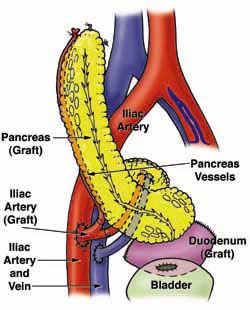
How a Pancreas Transplant is Performed
The transplant recipient's own organs are left in place and the new organs are placed in the lower abdomen. Preferably, the pancreas goes to the right of the bladder and the kidney (when needed) to the left.
The pancreas can be procured in one of two ways: it can be procured from a deceased organ donor or half of a pancreas can be procured from a living organ donor. In the case of a deceased organ donor, the duodenum (a part of the small intestine) is also transplanted because the head of the pancreas is intimately attached to it. In the case of a living organ donor, the tail of the pancreas is the part that is used.
Once procured, the donated pancreas is prepared by the surgeons to be put into the transplant recipient. Both extremes of a deceased donor duodenum are closed and a new opening is made. The donated pancreas is then attached to three places in the transplant recipient:
1. The portal vein coming from the donated pancreas is sewn to the recipient's iliac vein.
2. The pancreas arteries are sewn to a graft of donor's iliac artery, which is then sewn to the recipient's iliac artery.
3. The duodenum's new opening is sewn into the recipient's bladder that will eventually receive the exocrine pancreas secretions (enzymes).
Alternatively, the donor duodenum can be sewn to the recipient's intestine. The first two attachments establish blood flow to the pancreas, allowing insulin release. The third attachment allows the exocrine enzyme (amylase) to be excreted into the urine. Low amylase excretion is a good marker of a pancreas graft rejection episode needing treatment, particularly in the absence of a same donor kidney graft (in which case an increase in blood creatinine is a good parameter). The drainage into the bladder may lead to some post-transplant complications, in which case the recipient is reoperated and the same pancreas graft is attached to the intestine.
No comments:
Post a Comment